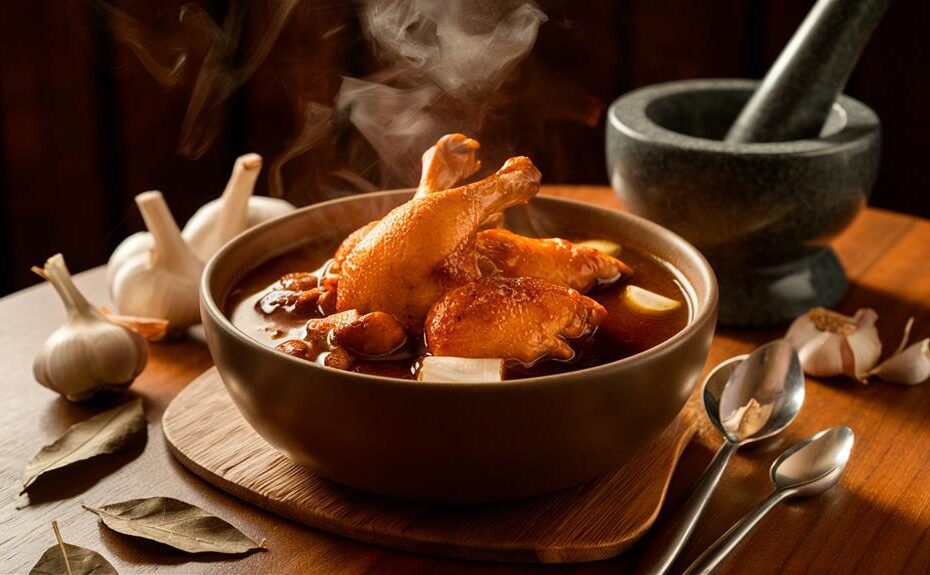Adobo is a traditional Filipino dish that predates Spanish colonization. The name 'adobo' is derived from a food preservation method using vinegar and salt, which is suitable for the country's humid climate. This method was adopted by the Filipinos and later influenced by Spanish, Chinese, and Malay cuisines.
Adobo is a staple dish in every region of the Philippines. Each region has its unique twist, showcasing the creativity and adaptability of the Filipino people. The core ingredients of adobo include vinegar, soy sauce, garlic, and various proteins. The combination of these ingredients creates a savory and slightly sour flavor profile that is universally loved.
The cultural significance of adobo can be seen in its variations. For example, chicken adobo is a classic variation made with chicken cooked in vinegar, soy sauce, garlic, and bay leaves.
Pork adobo is another variation made with pork cooked in vinegar, soy sauce, garlic, and black pepper. These variations demonstrate the versatility of adobo and its ability to adapt to different tastes and preferences.
Is Adobo Originally Filipino?
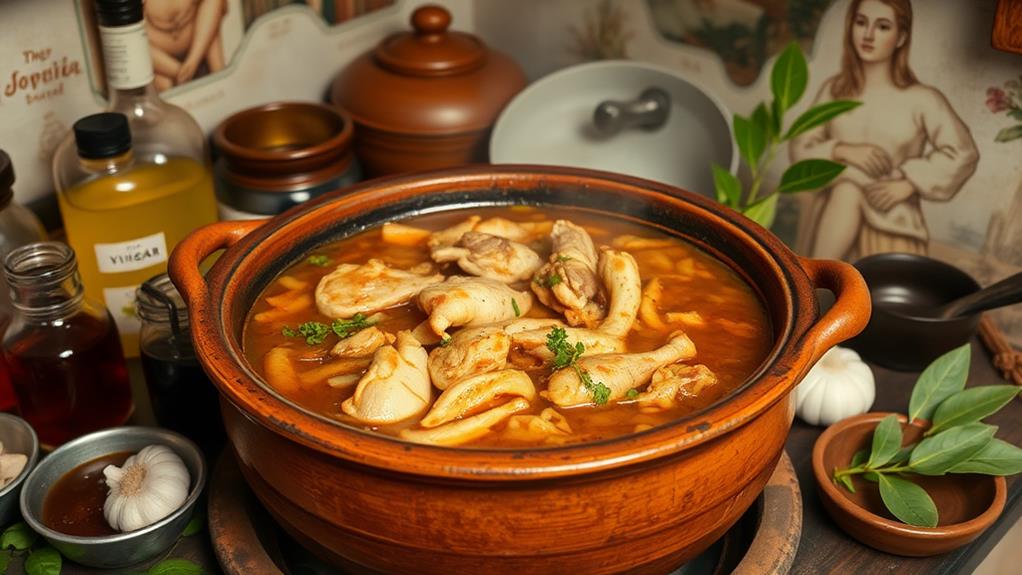
Adobo is indeed originally Filipino. The dish's cooking method, which involves using vinegar and salt to cook and preserve food, predates Spanish colonization. This technique, used by early Filipinos, dates back centuries and was a means of preservation due to the acidic nature of vinegar preventing bacterial growth in the hot and humid Philippine climate.
The core ingredients and cooking techniques of adobo remain rooted in the country's pre-colonial past. Over time, soy sauce was introduced by Chinese traders, and regional variations developed across the Philippines, reflecting local preferences and available ingredients.
These variations, such as the use of different types of vinegar or the addition of coconut milk, demonstrate the adaptability and creativity of Filipino cooks.
Understanding the history of adobo highlights its cultural significance and showcases the resourcefulness of Filipino cooks in preserving their culinary traditions.
How Do You Describe Adobo?
The Unique Flavor Profile of Adobo
Adobo's flavor profile is primarily defined by vinegar, soy sauce, black peppercorns, and bay leaves. These ingredients create a savory and slightly sour taste experience that distinguishes Filipino adobo from its Spanish and Latin American counterparts.
The Role of Vinegar in Adobo
The use of vinegar in adobo serves as a preservation method, adapted by early Filipinos to prevent bacterial growth in the tropical climate.
Vinegar's acidity helps to prevent spoilage, allowing for longer storage and consumption of food.
Regional Variations and Cultural Significance
Adobo's cultural significance is reflected in its regional variations and ingredient adaptations.
Different regions in the Philippines use local ingredients and preferences, resulting in unique versions of adobo that showcase the country's resilience and creativity.
Why Is Adobo the Philippines National Dish?
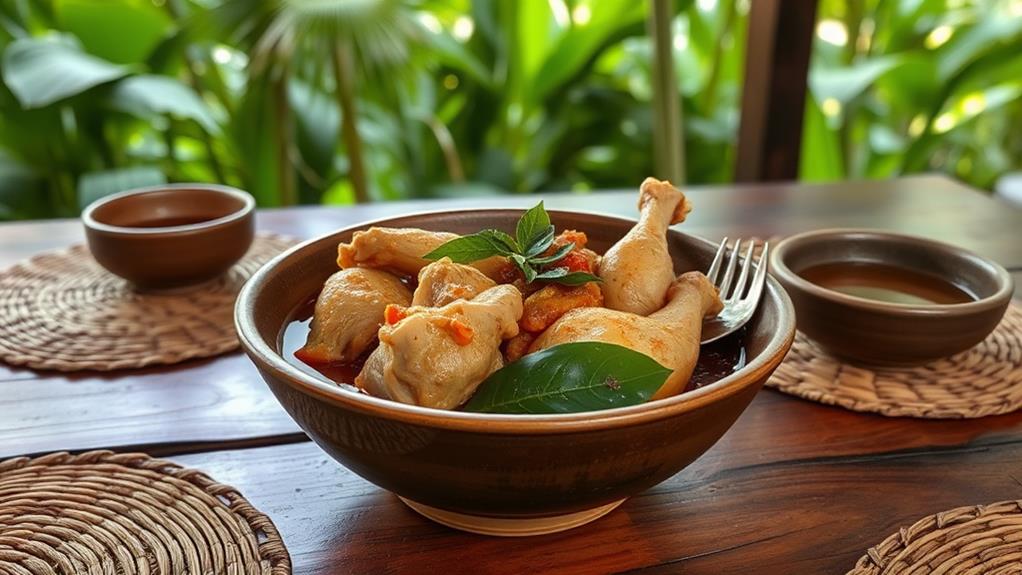
Adobo is widely regarded as the Philippines' national dish due to its profound cultural significance, versatility, and widespread popularity. This distinction is largely attributed to three main factors.
Historical influences played a significant role in adobo's status. The cooking method of preserving meat in vinegar and salt, which is indigenous to the Philippines, predates Spanish colonization. This shows that the dish has its roots in pre-colonial times.
Regional variations also contribute to adobo's national dish status. The dish's versatility allows for different regional variations, making it a staple in Filipino cuisine that's both unique and diverse in its interpretations.
The dish's adaptability and flavor combinations have made it a favorite. Adobo's complex balance of salty, sour, and aromatic flavors, along with its adaptability to various ingredients, has made it a favorite among Filipinos and foreigners alike.
For example, different regions in the Philippines have their own unique versions of adobo, such as Batangas-style adobo with pineapple or Cebu-style adobo with bay leaves.
Do Mexicans Use Adobo?
Mexicans use adobo in their cooking traditions. Adobo is a versatile sauce or marinade that adds depth to various dishes. To make Mexican adobo, you'll typically need ingredients like dried chilies, vinegar, garlic, spices, and sometimes tomato paste.
Mexican adobo has multiple uses in cooking. It's often employed as a marinade for meats, poultry, and fish. Adobo is also used as a flavoring for soups, stews, and rice dishes. Additionally, it makes a great sauce for dishes like enchiladas and tacos.
The flavor profile of adobo is smoky, slightly sweet, and spicy. This unique flavor comes from the combination of dried chilies, vinegar, garlic, and spices. The rich flavor of adobo pairs well with various ingredients, such as grilled meats, roasted vegetables, and warm tortillas.
Mexican adobo is a result of cultural fusion. The blend of traditional Spanish spices with indigenous Mexican ingredients has resulted in a unique adobo that's deeply rooted in Mexican cuisine.
Understanding the history of adobo in Mexico reveals this cultural fusion.
What Is the Philippines' National Dish?

The Philippines doesn't have an officially designated national dish, but several popular contenders are widely considered to represent Filipino cuisine.
Adobo is often referred to as the unofficial national dish of the Philippines. Its flavor profile is characterized by a balance of salty, sour, and sweet notes. This versatile dish is a staple in many Filipino households and is often served with steamed rice.
Sinigang is another top contender for the national dish title. This sour soup is known for its tangy broth and variety of proteins and vegetables. Regional variations of Sinigang use different souring agents, such as tamarind, guava, or mango, which reflect the country's diverse flavor profiles.
Lechon is a staple at many Filipino celebrations and feasts. A whole roasted pig, Lechon is a beloved dish across the country, known for its crispy skin and flavorful meat. Its popularity spans across different regions, making it a strong contender for the national dish title.
These dishes highlight the Philippines' complex culinary landscape, with each region boasting its own unique flavors and specialties.
Is Adobo Healthy?
Chicken adobo can be a part of a balanced diet when prepared with healthier ingredients and techniques. Traditional recipes often contain high amounts of sodium and saturated fat, primarily due to soy sauce and skin-on chicken thighs.
To reduce sodium content, using low-sodium soy sauce is a healthier alternative. For lower saturated fat, opting for skinless chicken breast instead of thighs is recommended.
Incorporating brown rice instead of white rice adds fiber to your meal. Apple cider vinegar, which may have additional health benefits, can be used as a substitute for regular vinegar.
By making these simple substitutions, you can enjoy the nutritional benefits of chicken adobo, including high-quality protein, essential vitamins, and minerals.
Maintaining mindful portion sizes and using healthier ingredients is key to savoring this flavorful dish while maintaining a balanced diet.
Is Adobo a Filipino Chinese or Spanish Dish?

The name "adobo" may suggest a strong Spanish connection, but its cultural heritage is more complex. The term "adobo" comes from the Spanish word "adobar," meaning "to marinate." However, the core cooking method of adobo is indigenous to the Philippines.
Filipino adobo has been shaped by various cultural influences over centuries, including Chinese trade. Soy sauce was likely introduced to many Filipino adobo recipes through Chinese trade. The dish's evolution reflects the country's unique cultural fusion.
Three key aspects set Filipino adobo apart from its Spanish and Chinese counterparts.
Filipino adobo relies on native ingredients like vinegar, garlic, and black peppercorns, which pre-date Spanish colonization. This differentiates it from Spanish versions, which may include ingredients introduced by Spanish colonizers.
Filipino adobo has a distinct salty, sour, and often sweet taste. This flavor profile is unlike the spicier versions found in Spanish cuisine.
Filipino adobo exists in countless regional variations across the Philippines. These variations reflect regional ingredients and family traditions, showcasing the dish's adaptability and diversity.
Is Mexican Adobo the Same as Filipino?
Mexican Adobo and Filipino Adobo are Not the Same
Although both Mexican and Filipino cuisines have a dish called "adobo," they're two distinct culinary preparations. The main difference lies in their ingredients, preparation methods, and cultural contexts.
Mexican adobo is primarily a sauce or marinade made from dried chilies, spices, and vinegar. This is used to marinate meats before grilling, giving them a rich and spicy flavor.
In contrast, Filipino adobo is a complete dish that consists of meat, seafood, or vegetables marinated and then cooked in a mixture of soy sauce, vinegar, garlic, and other seasonings.
The history and influences of both cuisines play a significant role in shaping their adobo variations. Mexican adobo is a fusion of Spanish and indigenous influences, while Filipino adobo is considered an indigenous cooking method that predates Spanish colonization.
As a result, the adobo techniques used in both cuisines differ. Mexican adobo is often used as a marinade, while Filipino adobo involves simmering the ingredients until the meat is tender.
Despite these differences, both Mexican and Filipino adobo share some common elements, including the use of vinegar and garlic as key ingredients.
What Is Adobo Served With?
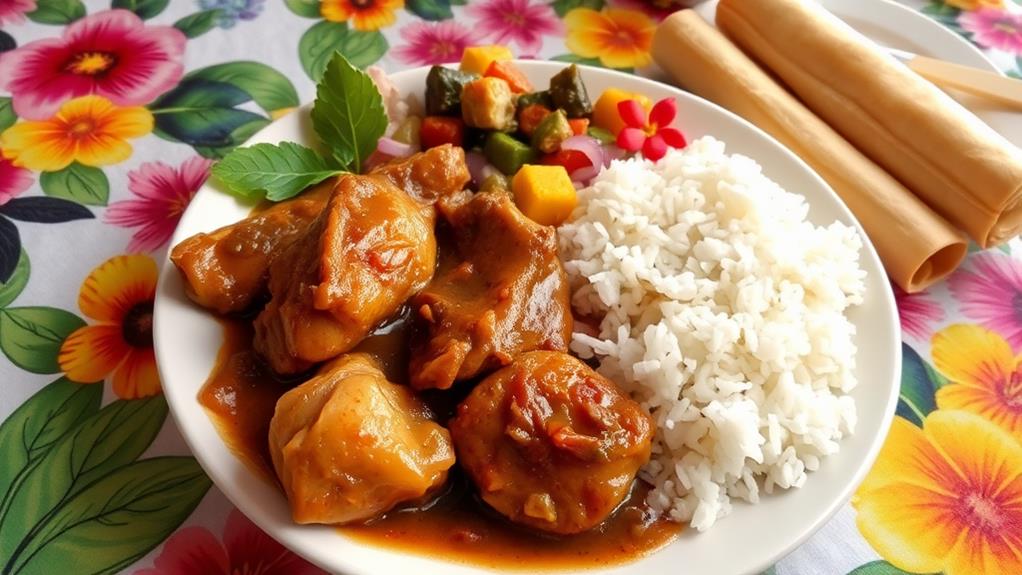
Adobo is traditionally served with accompaniments to balance out its rich flavors. Steamed white rice is the most essential side dish for adobo, as it helps to soak up the flavorful sauce and balance out the strong flavors.
Vegetables are also common accompaniments to adobo. Green beans or string beans pair well with adobo, adding a burst of freshness to the dish. These vegetables can be served steamed or sautéed, depending on personal preference.
A simple cucumber salad can provide a nice contrast to the rich flavors of adobo. A cucumber salad made with thinly sliced cucumbers, onions, and a citrus dressing is a popular accompaniment.
This side dish helps to cut the richness of the adobo, creating a well-rounded meal.
Who Invented Adobo?
The origins of adobo can't be attributed to a single person. This traditional Filipino cooking method is a result of centuries-long evolution. Early Filipino natives developed the cooking technique to preserve food in the hot, humid climate. They used vinegar and salt to marinate meat, a crucial preservation technique for survival in tropical conditions.
The introduction of soy sauce by Chinese traders marked a significant turning point in the evolution of adobo. As Chinese traders visited the Philippines, they introduced soy sauce, which was gradually incorporated into the existing vinegar-based cooking method. This addition contributed to the development of the adobo dish as we know it today.
The term "adobo" was applied by Spanish colonizers. The Spanish recognized the similarities between this cooking method and their own dishes, leading to the adoption of the term "adobo."
Over time, adobo has evolved into numerous regional and family variations across the Philippines, reflecting the country's diverse culinary heritage and cultural influences.
Key variations of adobo showcase its adaptability. These variations demonstrate the adaptability of adobo's core cooking techniques, which have been shaped by various regional ingredients and preferences.
Where Is Adobo Most Popular?

Adobo is most popular in the Philippines.
The dish is a staple in every region, with each having its unique twist on adobo.
The Philippines' adaptability and cultural identity contribute to adobo's widespread popularity.
Three key aspects of adobo's popularity in the Philippines are:
- Regional variations exist, with examples including Batangas' "adobong dilaw" (yellow adobo), Cavite's version with mashed pork liver, and the Bicol region's "adobo sa gata" (coconut milk adobo). These variations demonstrate the dish's rich history and the creativity of Filipino cooks.
- Common ingredients in adobo include protein (chicken, pork, or a combination of both), vinegar, soy sauce, garlic, and bay leaves. These ingredients are staples in Filipino cuisine.
- Adobo often represents the country's history, culture, and traditions. It's often served with steamed rice and is a staple in Filipino cuisine.
What Is More Popular, Adobo or Sinigang?
Adobo is Slightly More Popular Than Sinigang in the Philippines.
Adobo and sinigang are two of the Philippines' most iconic dishes, boasting a rich culinary history. Both have become staples in Filipino cuisine, but their popularity varies.
Adobo's global recognition and adaptability give it a slight edge in popularity. This dish is widely recognized internationally and within the Philippines, with a distinct flavor profile that works well with various protein options. For example, adobo can be made with chicken, pork, beef, or seafood, making it a versatile dish.
Sinigang, on the other hand, is extremely popular within the Philippines, especially during rainy seasons. This dish has a unique sour soup base and regional variations, which contribute to its loyal following. While sinigang isn't as globally recognized as adobo, it remains a close second in terms of popularity in the Philippines.
Regional differences and personal preferences play a significant role in determining the popularity of these dishes. However, adobo's flavor profile is more accessible to international palates, contributing to its slightly higher popularity.
What Culture Is Adobo From?

Adobo originates from Filipino cuisine. This dish's cultural significance and widespread popularity in the Philippines predate Spanish colonization. Three key aspects define adobo's cultural origins and significance in the Philippines.
Adobo's cooking method is indigenous to the Philippines. This method uses vinegar and salt to preserve and flavor meat, which is essential in the tropical climate. For example, Filipinos traditionally cooked meat using a combination of vinegar, salt, and other local ingredients to create a flavorful and preserved dish.
Chinese traders later introduced soy sauce, which was incorporated into some adobo recipes, adding a new dimension to the dish. This influence can be seen in many Filipino adobo variations that include soy sauce as a key ingredient.
The name "adobo" comes from the Spanish word for marinade, which was given by Spanish colonizers in the 16th century. They observed the native cooking method and named it after a similar Spanish dish.
Filipino adobo has a distinct flavor profile and ingredients, setting it apart from other adobo variations. The dish's cultural significance extends beyond its preservation and ingredients, with countless regional and family variations of adobo across the Philippines.
What Is the National Dish of Adobo?
The Philippines' Unofficial National Dish is Adobo.
Adobo is widely regarded as the national dish of the Philippines due to its widespread accessibility of ingredients across the country, versatility in preparation and ingredients, and long shelf life. This dish is characterized by slow-cooking meat, seafood, or vegetables in a mixture of vinegar, soy sauce, garlic, and spices, resulting in a distinct flavor profile.
Adobo's adaptability is showcased in regional variations such as Adobo sa Gata, Adobong Puti, and Adobong Dilaw, which incorporate local ingredients. For example, Adobo sa Gata uses coconut milk, a common ingredient in southern Philippines. These variations highlight the dish's ability to adapt to different regional tastes and ingredients.
Historical influences from Spanish colonization and Chinese traders have shaped the evolution of adobo. The use of soy sauce, for instance, is a result of Chinese traders who arrived in the Philippines. This blend of cultural influences has contributed to adobo's unique flavor profile and its significance in Filipino cuisine and culture.
Adobo's cultural variations, cooking techniques, regional ingredients, and historical influences all contribute to its importance in the Philippines. The dish's versatility, accessibility, and distinct flavor profile have cemented its status as a staple in Filipino cuisine and culture.
What Is an Interesting Fact About Adobo?

One interesting fact about adobo is its origins as a food preservation method in the Philippines. The combination of vinegar and salt in the adobo marinade created an acidic environment that inhibited bacterial growth, allowing the meat to be stored for longer periods without spoiling.
Adobo's origins as a preservation technique have had a lasting impact on the dish's cultural significance. This practical origin led to adobo becoming a widespread and popular dish throughout the Philippines.
Three key aspects of adobo have been influenced by its preservation methods.
- Regional variations have developed unique takes on adobo, often incorporating local ingredients and cooking techniques. For example, the Bicol region in the Philippines is known for its use of coconut milk in adobo recipes.
- Preservation methods continue to influence adobo preparation, with many recipes still relying on vinegar and salt to extend the dish's shelf life. This is especially true in areas where refrigeration isn't widely available.
- The flavor profile of adobo has been shaped by its preservation methods, with the combination of vinegar, soy sauce, and other spices creating a distinctive flavor profile synonymous with Filipino cuisine.
What Is the Disadvantage of Adobo?
The Disadvantages of Adobo
Adobo, a popular Filipino dish, has some significant health drawbacks.
One major disadvantage of adobo is its high sodium content. This is mainly due to the use of soy sauce and salt in traditional recipes. Consuming excessive sodium can contribute to high blood pressure and cardiovascular issues.
Unhealthy cooking methods can also be a disadvantage of adobo. Frying, a common method used to cook adobo, adds unhealthy fats and extra calories. This can lead to weight gain and other health problems.
Another concern with adobo is nutrient loss. The boiling process used to cook the dish can result in a loss of water-soluble vitamins and minerals. These essential nutrients are vital for maintaining good health.
Traditional adobo recipes often focus on meat and have limited vegetable content. This can make the dish unbalanced and less nutritious. To make adobo healthier, it's essential to incorporate a variety of vegetables.
| Health Concerns | Description |
|---|---|
| High Sodium Content | Excessive sodium intake from soy sauce and salt |
| Unhealthy Cooking Methods | Frying adds unhealthy fats and extra calories |
| Nutrient Loss | Boiling process leads to loss of water-soluble vitamins and minerals |
| Limited Vegetable Content | Traditional recipes focus on meat with minimal vegetables |
What Makes Adobo Good?
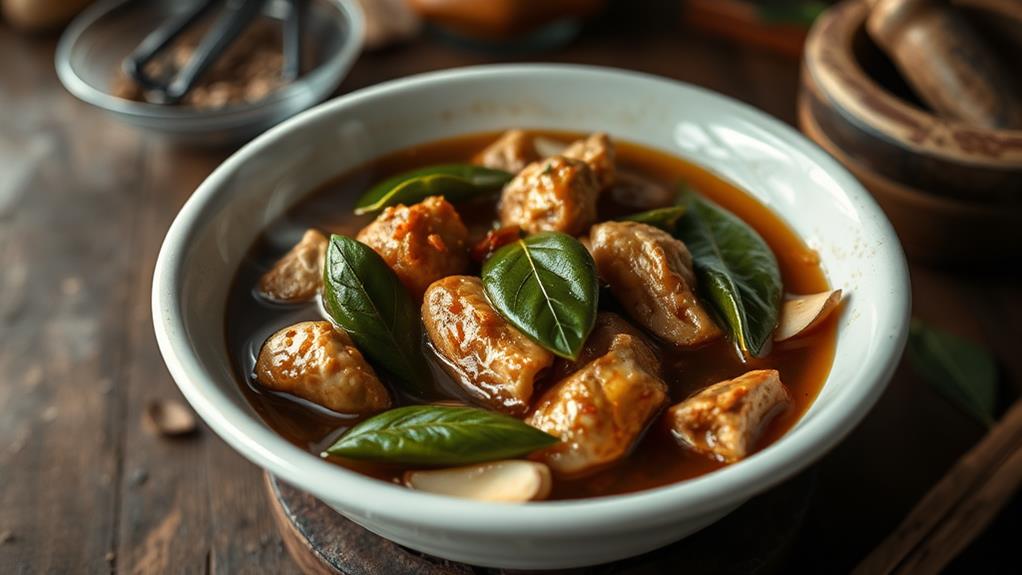
The combination of balanced flavor profile, cooking techniques, and high-quality ingredients makes adobo a beloved Filipino dish.
1. The perfect harmony of vinegar and soy sauce creates a balanced flavor profile. This balance comes from the tangy note of vinegar, which is offset by the depth and umami of soy sauce.
For example, a common ratio of vinegar to soy sauce is 1:1, but this can be adjusted to suit individual tastes. Vinegar adds a bright, tangy note, while soy sauce adds a deeper flavor and umami.
2. Slow-cooking or braising the meat allows the flavors to meld and the meat to become tender. Initially searing the meat develops a deeper flavor and better texture.
This technique is crucial, as it helps to break down the connective tissues in the meat, making it tender and juicy.
3. Using fresh garlic, whole peppercorns, and good quality vinegar and soy sauce elevates the dish. Fresh ingredients ensure the best flavor and aroma.
For example, using fresh garlic instead of garlic powder adds a pungency and depth to the dish. Similarly, using whole peppercorns instead of ground pepper adds a more nuanced flavor.
What Is the English of Adobo?
The English meaning of "adobo" refers to a complex culinary concept with multiple uses.
The term "adobo" has multiple meanings, primarily referring to a popular Filipino dish, a cooking method, and various other culinary uses. In the context of the Filipino dish, adobo consists of marinated and simmered meat, seafood, or vegetables in a sauce containing vinegar, soy sauce, garlic, black peppercorns, and bay leaves. This dish is often considered the unofficial national dish of the Philippines.
In a broader sense, adobo refers to a cooking process that involves browning ingredients in oil, followed by marinating and simmering in vinegar, salt or soy sauce, and garlic. For example, in Filipino cuisine, adobo is typically made by browning meat or seafood, then simmering it in a mixture of vinegar, soy sauce, garlic, and spices.
In contrast, Latin American adobo refers to a spicy marinade, while Spanish adobo can refer to a marinade, sauce, or seasoning. Understanding these nuances is crucial to appreciating the rich history and cultural traditions behind this complex culinary concept.
Why Do Filipinos Eat Adobo?
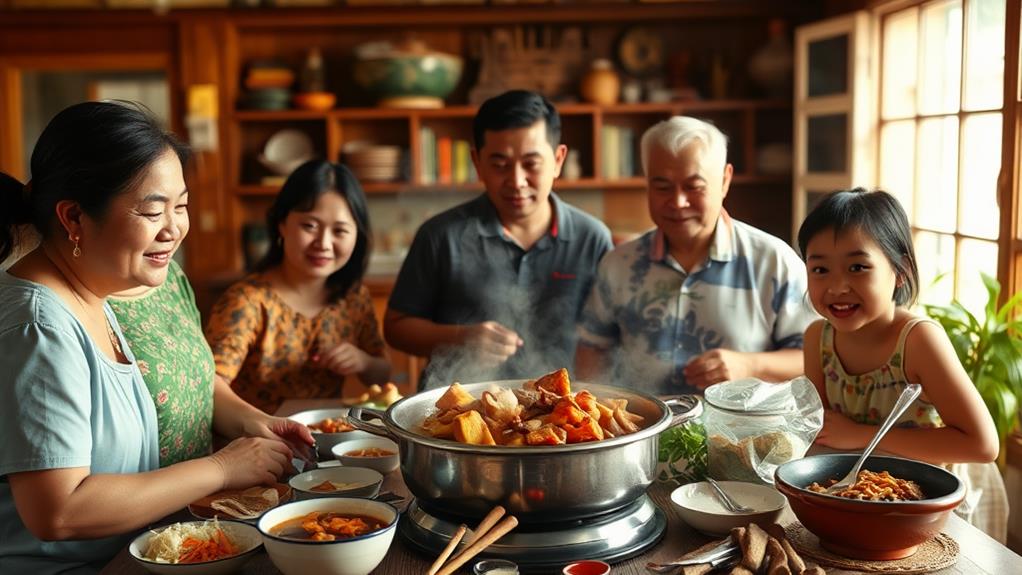
Filipinos' affinity for adobo stems from its multifaceted significance in their culture and daily lives. Adobo plays a crucial role in shaping their culinary identity due to its practical benefits, rich flavors, and cultural significance.
The practicality of adobo makes it a staple in Filipino cuisine. The use of vinegar and salt in adobo allows for food preservation, making it ideal for areas without reliable cold storage. For example, in rural areas where refrigeration is scarce, adobo's preservation qualities ensure a steady food supply.
Additionally, adobo's versatility accommodates various proteins and ingredients, making it an ideal dish for households with diverse tastes and dietary needs.
The flavor profile of adobo is another key reason for its popularity. The combination of vinegar, soy sauce, garlic, and black pepper creates a tangy, savory taste that's both complex and balanced.
Regional variations of adobo add a rich layer of diversity to the dish, with different provinces and islands offering unique twists on the classic recipe. For instance, in the Visayas region, adobo is often cooked with coconut milk and spices, giving it a distinct flavor.
The cultural significance of adobo is deeply rooted in Filipino tradition. Adobo traditions and variations have been passed down through generations, with each recipe telling a story of its own.
Whether it's a family gathering or a casual meal, adobo cooking is always at the heart of Filipino cuisine. In many households, adobo is a staple dish cooked for special occasions and everyday meals alike, fostering a sense of community and shared identity among Filipinos.
What Is Adobo as a Filipino Identity?
Adobo is an integral part of Filipino identity, extending far beyond being just a dish. Its history dates back to pre-colonial times in the Philippines, where indigenous Filipinos practiced stewing meat in vinegar to preserve food in the tropical climate. This cooking method was a crucial adaptation to the local environment and showcases the resourcefulness of early Filipinos.
The dish's versatility and regional variations reflect the diversity of Filipino culture. Adobo can be made with different proteins, such as chicken or pork, and even vegetables, depending on local tastes and available resources.
For example, in the northern region of the Philippines, Adobo is often made with bagoong, a type of fermented fish sauce, while in the southern region, it's commonly made with coconut milk. These variations demonstrate the adaptability and creativity of Filipino cuisine.
Adobo embodies the nation's history, diversity, and culinary heritage. Its significance extends beyond being a simple dish, representing the shared experiences and memories of Filipinos across different regions and backgrounds.
Adobo is a powerful symbol of Filipino identity, reflecting the nation's values of resilience, adaptability, and community.
How Should Adobo Taste?
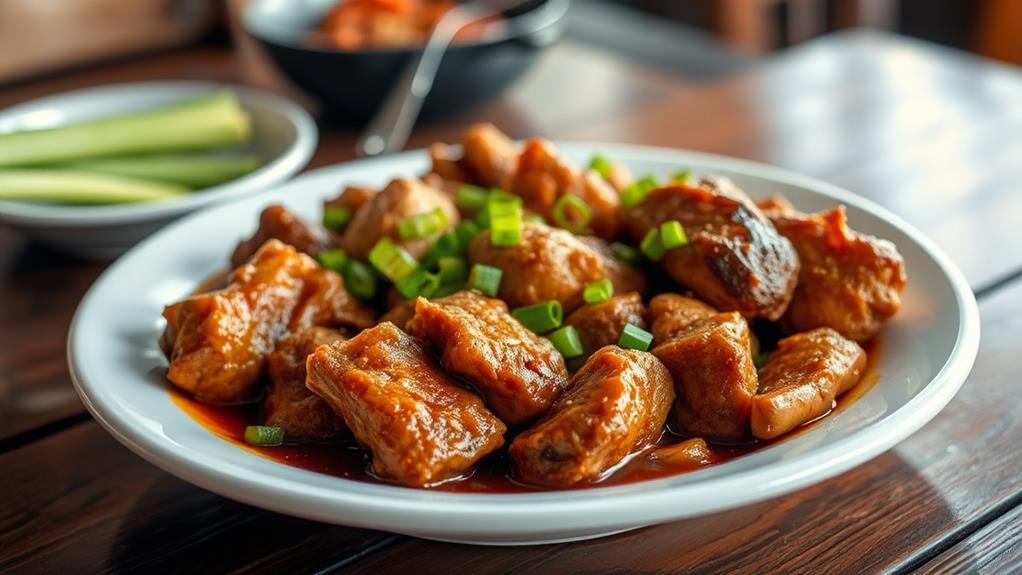
A good Adobo should have a harmonious balance of savory, tangy, and slightly sweet flavors. This balance is achieved through a combination of three key elements: savory and umami, tangy and sour, and subtle sweetness.
Savory and umami flavors in Adobo come from ingredients like soy sauce and garlic. Soy sauce provides a rich umami flavor, while garlic adds a pungent, savory undertone.
The tangy and sour flavors in Adobo are primarily provided by vinegar, which can be white, rice, or cane vinegar. Vinegar adds a prominent tangy note that cuts through the richness.
A hint of sweetness, often from brown sugar or other ingredients, balances the sour and salty flavors in Adobo. This subtle sweetness is essential to achieve the desired flavor balance.
Regional adaptations, ingredient substitutions, and personal variations can affect the flavor balance of Adobo. However, a good balance of flavors and tender, juicy chicken are essential for an authentic and delicious Adobo dish.
What Makes Adobo Special?
Adobo is a quintessential Filipino dish with a unique flavor profile. This flavor profile is the result of a harmonious blend of tangy, salty, savory, and subtly sweet flavors, which creates a complex taste that surpasses the sum of its individual components.
For instance, the combination of vinegar, soy sauce, and garlic gives Adobo its distinctive flavor.
Adobo's versatility is a key factor in its special status. Its versatility allows for experimentation with various ingredients, such as different meats (chicken, pork, or beef), seafood (shrimp or fish), or vegetables (bell peppers or tomatoes).
Regional variations also showcase the diversity of Filipino cuisine, offering unique takes on the traditional recipe, like the use of coconut milk or different spices.
The cultural significance of Adobo is profound. It's often considered the unofficial national dish of the Philippines, reflecting the country's rich culinary heritage.
Adobo's cooking techniques, including braising and marination, result in tender, flavorful meat. Additionally, preservation methods, such as using vinegar and salt, naturally inhibit bacterial growth, making it ideal for travel or storage.
Why Is It Called Adobo?
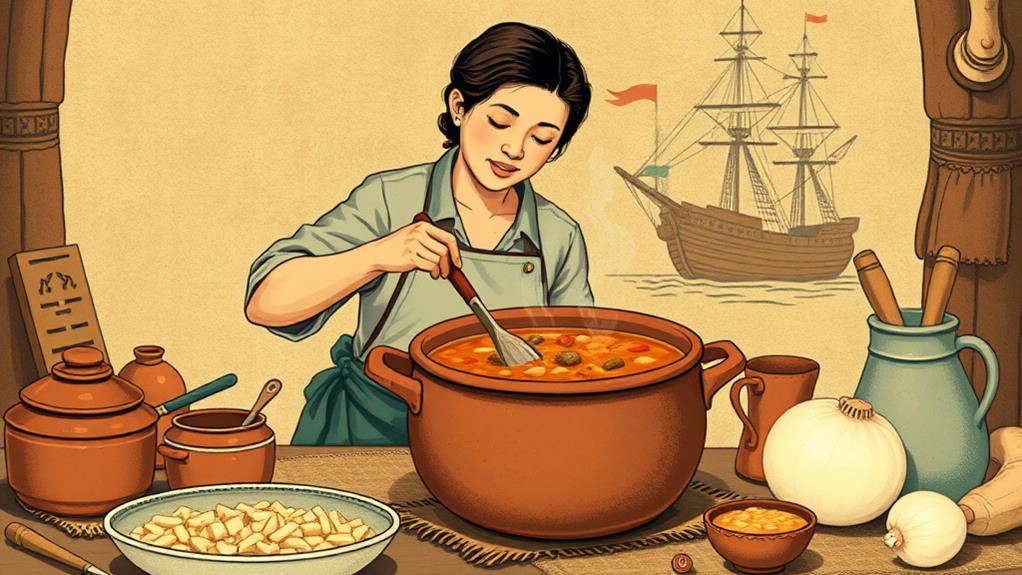
The term "Adobo" was applied to this Filipino dish by Spanish colonizers in the late 16th century. The Spanish word "adobar" means "to marinate" or "pickling sauce," which refers to the method of cooking meat or vegetables in vinegar and spices. This term stuck due to its superficial similarity to Spanish marinades.
The name "Adobo" represents the cultural exchange between the Spanish colonizers and the indigenous Filipino people. This cultural exchange occurred when the Spanish colonizers arrived in the Philippines and discovered the indigenous cooking method of marinating and stewing ingredients in vinegar, soy sauce, garlic, and spices.
Despite the Spanish name, the cooking method for Adobo is indigenous to the Philippines and predates Spanish colonization.
The term "Adobo" refers to a specific cooking process that involves marinating and stewing ingredients in vinegar, soy sauce, garlic, and spices. This process is distinct from Spanish adobo variations. For example, Filipino Adobo typically uses vinegar, soy sauce, garlic, and bay leaves to marinate and stew meat or vegetables, while Spanish adobo uses olive oil, vinegar, and spices.
The name "Adobo" has become synonymous with the unique flavor profiles that characterize this Filipino dish. These flavor profiles are distinct from Spanish adobo variations and are a result of the combination of ingredients and cooking techniques used in Filipino Adobo.
The name "Adobo" has become an integral part of Filipino cuisine and identity, despite its Spanish origins.
How Many Types of Adobo Are There?
There are numerous types of adobo, with variations in ingredients, cooking methods, and flavor profiles.
Filipino cuisine offers diverse adobo variations, making it challenging to provide an exact number of types. However, adobo can be broadly categorized into several groups.
Meat-based adobo variants include Adobong Manok (chicken adobo) and Adobong Baboy (pork adobo).
Seafood adobo options include Adobong Pusit (squid adobo) and Adobong Hipon (shrimp adobo).
Vegetable and legume adobo variations also exist, such as Adobong Kangkong (water spinach adobo) and Adobong Talong (eggplant adobo). These variations showcase adobo's adaptability to different ingredients.
Regional specialty variations are another aspect of adobo's diversity.
Examples include Adobong Puti (white adobo) and Adobong Dilaw (yellow adobo), highlighting the cultural significance of adobo in different parts of the Philippines.
Each region and household in the Philippines has its own preferred adobo version, contributing to the dish's enduring popularity in Filipino cuisine.
What Flavor Is Filipino Adobo?
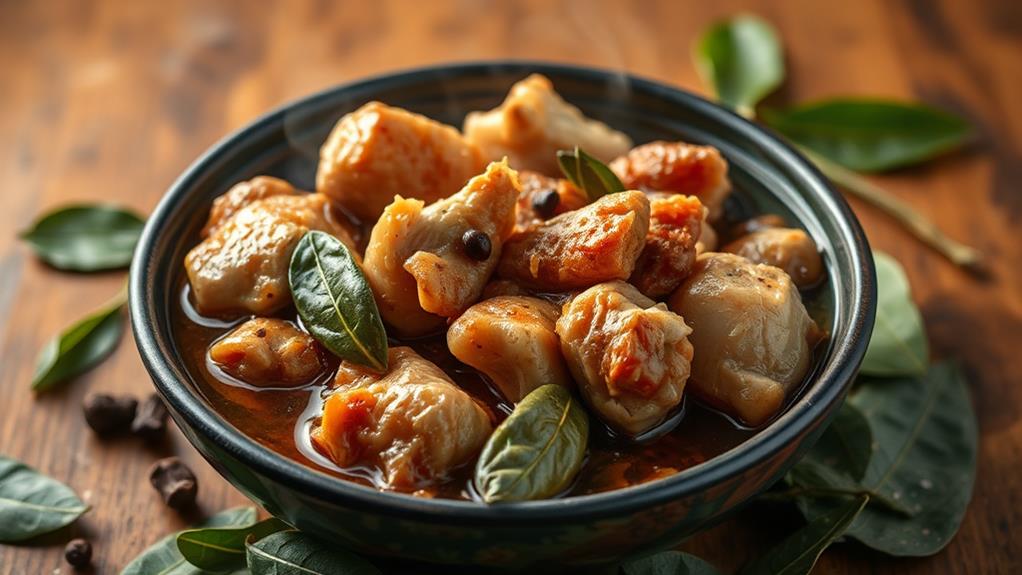
Filipino adobo is a unique blend of salty, sour, and umami flavors. This classic Filipino dish has a long history, with various variations emerging over time. At its core, the flavor profile of adobo consists of three primary flavors: salty, sour, and umami.
The primary flavors in Filipino adobo come from soy sauce and vinegar, which provide a salty and sour taste, respectively. These core flavors are complemented by secondary flavors such as garlic, adding a pungent and aromatic taste; black pepper, providing a subtle heat and spiciness; and bay leaves, contributing a mild and herbal note.
The cooking process also plays a crucial role in shaping the flavor profile of adobo. The slow cooking process enhances the umami taste, while the addition of coconut milk or sugar adds a touch of creaminess and sweetness.
A well-balanced adobo dish presents a harmonious blend of salty, sour, savory, and slightly sweet notes.
